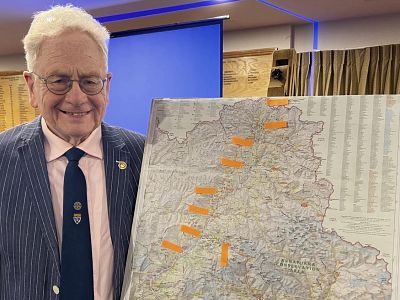Geology and poetry might not be thought of as natural partners - but they were brought together by PP & Rotarian Richard Kemball-Cook when he spoke to our club about his Himalayan Adventures in the former "hidden kingdom" of Mustang in Nepal.
In her introduction as she invited Richard to the floor, President Rosemary described him as an "intrepid" explorer - he's spoken to our members and guests before about his travels to the Annapurna massif. This time he would be talking about his latest, 15-day Nepalese trip.
"This will be a journey into the forbidden kingdom of Mustang," said Richard at the start of his talk, adding how the area had been "secret" until it opened up in 1992. It was a place that Richard had been keen to visit ever since he'd first got a tantalising glimpse of it during his Annapurna trip.
Richard had gone on the Mustang expedition with a group of “avid geologists”, one of whom he'd had known for a number of years. It was quite an enlightening experience to go with them, it seems. "“The whole thing about mountains is we all react to them in different ways: some people paint them, while others are inspired to write poetry” said Richard before adding, rather wryly, "Geologists always ask: 'Why'?"
It's lucky for us that they do have this curiosity, because through Richard they gave us great insight into the world of mountains, valleys and other geological wonders. For example, we were fascinated to learn that at the very top of Mount Everest one can find sedimentary rock with evidence of animals from the sea - giving us a clue about how the famous mountain range had come to be.
Early in his talk Richard showed a map of the region (see picture), pointing out the route that his group of adventurers had taken, Much of it followed the so-called trading "Salt Route" of old. And as he showed us another map he pointed out that there are rivers in Tibet that go south ... through a mountain range. "How did this happen?" he rhetorically asked.
This is when Richard reminded us about continental drift (sharing an anecdote along the way of how he'd cut pictures of the continents when he was at school and observed how they all "fit" together.) Once, continents had been joined together, but over geological time they had moved apart and drifted in different directions. The Indian subcontinent had, in effect, "shunted northwards" from the African continent. Intriguingly, one way that geologists know this is through studies that have shown a commonality in organisms from different continents, an indication of just how continents shifted. The Indian Subcontinent had "hit" the rest of Asia with much force - crumpling the land into mountain peaks and valleys, just as one might see a car do in a movie of a car crash.
Richard's journey in Nepal had started at Kathmandu; from there the adventurers travelled to Pokhara, from where they saw the extraordinary Fishtail Mountain (Machhapuchhare) that towers over Pokhara. This was the start of their expedition proper.
During his talk - illustrated with extraordinary pictures captured, surprisingly, on his iPhone - Richard told us about various things he'd seen and learned during the trip - giving us snippets about the rivers, mountains, rock and river beds. The latter were particularly interesting to the geologists as they were full of pebbles; further geological insights were to come from rock formations etc.
Altogether, there were around 25 people in the group - including a number of Sherpas who would help group members on the trek. “I wasn’t too sure of my own role,” said Richard. The group was full of people with different geo-backgrounds: the doctor with an interest in geology, the petroleum geologist, the academics ... and so on. But it turns out that eventually Richard did find his unique niche: when looking online, he'd come across The Geological Society's poetry group. So he got his travelling group all reciting poetry!
At this point Richard invited PP Peter Hermitage to the floor to read out the first poem of the evening: "A conversation with a pebble” by Alyson Hallett.
The group didn't just see rocks and stones on their travels - along the way they also passed local communities. Richard showed pictures of clothes on the line and people weaving baskets.
Next Richard called his wife, Cora, to the floor to read a poem called "Borrowdale" by Barbara Cumbers.
Richard went on to show us pictures of Buddhist temples, lavishly decorated in bright colours. We were also treated to a wonderful clip of chanting monks and people receiving blessings.
But not everything was idyllic as it may have at first sounded. The group had to contend with altitude sickness (the peak height was around 3800 metres!) and temperatures at night as low at -7 degrees C. And, as Richard matter-of-factly described, “we did attract the attention of police; in fact the group got arrested" - all because there had been earlier reports of clandestine searchers of uranium. Fortunately, the group were able to prove they were just vising the area - thanks no doubt to one member being an author who happened to have a copy of his book to hand. Even so, they did have some of their equipment seized!
Next Richard said, with some dry amusement: "I got lost". He added: "I seem to have a habit of getting lost in unusual places!" - alluding to the time during his Annapurna trip that he and Cora had got lost! He showed us a picture of a rather long-horned bull he'd encountered on a narrow path that seemed to be coming his way. "I've never moved so fast," he said.
Becoming lost seemed to tip Richard's imagination into overdrive! "I must admit I was wondering what I should do if I couldn't find my way back ... I even wondered if I would have to take a local wife!"
Thankfully (to Cara's relief, no doubt), he WAS able to find his group - though it seemed they hadn't missed him as much as he might have hoped. "We’d been wondering where you are," they casually said on his return, adding "because there was a space in the car"!
Next, Richard showed us a picture of a mountain with a massive fault line. How did this come about? "Well, if you get four geologists together you get five explanations," laughed Richard.
The group progressed in their travels on to a mountain desert area. Here, the geology was very different again. And the term "desert" shouldn't fool you into thinking it was warm - it most definitely was not! While there they saw school children and a group of local women sheltering from the cold wind and spinning and weaving yak wool!
The terrain changed more and more as the group went higher and higher; the walk became harder, the air thinner, and the altitude sickness became difficult for some group members. But some wonderful sights made up for this - there was a beautifully decorated famous temple they were able to see in Mucktinah (the area had Buddhists and Hindus); it was a relic of the Salt Path and a reminder of the wealth that had once existed along the route.
Richard's next picture actually drew gasps from the audience: it showed a very long, narrow swing bridge spanning its way from one mountain to the next. It turns out even intrepid Richard wasn't brave enough to cross it fully - though he did go a little way!
Finally, Richard called Rtn Robin Vickers to the floor: Robin gave an amusing rendition of a poem called "Dave was the very model of a student of geology” by Stuart Harker.
And with that Richard's visual account of his trip came to an end; it was followed by a short Q&A session during which further facts were relayed. Quite an amazing journey, we had to agree!
If you would like to hear Richard talk again you can do so on Friday 3rd November, when Richard will be joined by poet Victoria Field and others as part of the Canterbury Festival - details here.
Picture: Richard pictured next to a map of the route that he and his fellow travellers took. Picture credit: The Rotary Club of Canterbury.



